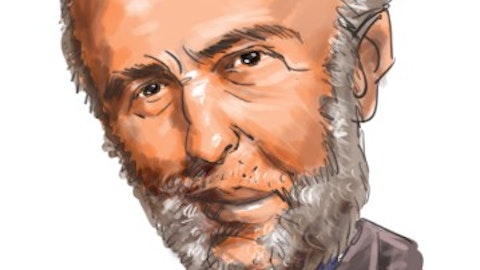Gayn Erickson: Yeah. That’s a good question. Maybe I’ll come back. I’m not sure I want to get into all that with all of the introductions, Larry, and I’m not trying to skirt it or something. But there is an indexing time as we would refer to it, how long it takes to index a WaferPak. And if you had 18 wafers — but if you — yes, I mean if you’re looking at 6 hours or 2 hours or 2.5 hour burn-in times, it’s negligible in the background, okay? At some time, you would start to notice it. I mean if you had 1 win at test times or something like that, then that would — you would start to eat into the overall throughput because of the indexing time. But your first comment is dead on though. This changes things. You would never do — trying to do a 2 hour test time on a burn-in system is would never work because it takes 15 minutes or 30 minutes to ramp up the chamber and 30 minutes to ramp it down before you can pull the devices out, and it takes hours to exchange all the devices on what’s called the burn-in boards.
The whole processing of the historical package part burn-in has so much overhead associated with it that I’d tell you people resisted at all costs. Not to mention the cleanliness and the quality implications of package for burn-in of having to scratch the leads and have these in these processes where they could actually introduce a failure into, trying to get to zero PPM defects where the package for burn-in system is extremely difficult. Whereas in a clean wafer environment, where we can make a contact with that wafer 100,000 times with the same WaferPak and never have a different measurement result, you can’t do that in a packaged part burn-in system. So there’s opportunities that will expand by us taking this tool, making it look now as a high-volume production tool where you can walk up to it with or use overhead material handling and drop it down without even touching or we have systems that use robots that move boots (ph) onto our auto liners today.
So you can actually be hands free. And using a interface front end into a wafer fabrication, you don’t even need to touch the tool.
Larry Chlebina: I think wafer level burn-in from the 1980s into the 21st century. I think it’s just a huge advancement.
Gayn Erickson: I’m with you.
Larry Chlebina: There’s process engineers sitting around with problems, trying to figure out how to characterize their devices for either sorting purposes or whatever. And I think if they had a sense that there’s a system out there that could stress them and then get a measurement and if the throughput was, say, 30 wafers per hour. If that cycle time of moving a WaferPak, unloading it, putting a new wafer in aligning it, putting it back into the system. If that’s on the order of 2 minutes, that’s 30-minute wafer per hour system. That probably would raise some eyebrows and probably drive demand from places you and I and anybody else hasn’t thought of yet. So anyway, it’s just
Gayn Erickson: Yes. I’m obviously a big believer. It’s one of my absolute pet projects, and I’m very passionate about it. I mean, Larry, one of the subtle things too is, remember that we’re putting these systems into large multinational, multiproduct line companies, okay? There is no such thing as a broad wafer-level burn-in system out there. There are companies in the memory side that are doing kind of a wafer level burn-in step using standard probers, okay? But they again — they’re all memory guys. They either do flash or DRAM or both. I mean there’s not much. You put one of these systems into a silicon carbide floor in one of the big multinationals and deploy it in a large scale, they’re going to know about it. I mean, their CEOs are signing off on the money for it.
So they’re going to know that it exists and they can say, well minute, could we use it over here. So I’m completely on board with you. And really excited that we’re turning the corner, not just for Aehr Test, but really wafer level burn-in for the first time in history.
Larry Chlebina: Great. Are you going to update your website to show this beast you still have that old clunker?
Gayn Erickson: Yes. Well, I’ll go beat up, Vernon and his team about a little bit. We’ve got the systems here and there — if you’re a tester guy, they’re beautiful. It’s like — they’ve got pictures out next to my children. But yeah, I think it’s about time for us to put something out there, but stay tuned.
Larry Chlebina: And one last quick question. As you know, being in the industry as long as you have, a slowdown in, say, the memory space is the opportune time to get your foot in the door for new technology, certainly an automated wafer level burn-in system, particularly as they’re getting money from the Feds to at least break ground on new fabs that probably won’t come online for years. But — now is the time to get your foot in the door for tool of record designation. And I just — I wonder if one of your sales guys is oriented towards that goal.
Gayn Erickson: That’s a fair statement. I also concur with you. We used to refer to as straights and turns. During the straightaways, it’s really tough to sell test equipment or any new process tool of record. They are just ramping and that’s what we saw over the last few years. And scenario with these new products and customers were selling the heck out of the old stuff. And we were not seeing that strength. Then in the terms €“ the turns that happened now the straightaway for silicon carbide, we’re super excited about it. But you’re right, the memory guys who are right now relooking at their business models and their cost structure and everything else, I think, would be — have a vested interest to review what we have as a product offering.
Larry Chlebina: All right. So hopefully, we get an announcement here soon that — would the process be an tool, would you announce that somebody got tool to run it through its paces?
Gayn Erickson: I’m always cautious about getting too far out ahead of our skis and giving people a heads up of what we’re up to. But there’ll be — when the timing is right, as people know from my background, I came from a memory business. I’ve always been extremely passionate about memory, and we — Aehr is always getting into the memory business. We have some examples and some wins of proof of concept of us to be able to do flash or memory on these tools. We’ve even done prototype proof of concepts for DRAM in the past as well. And I believe that, that is an opportunity. There is also a sense right now, candidly, of us making sure that the bulk of our resources are focused on the obvious immediate opportunities in front of us of trying to win every single company we possibly get in silicon carbide gallium nitride and the silicon photonics where our strengths are, but we do have energy into the memory as well. So I’ll better leave it at that, okay, Larry?




